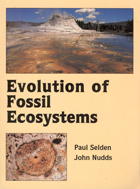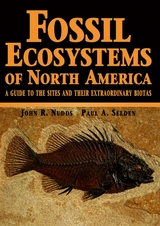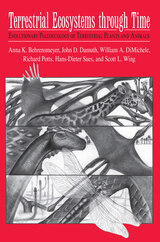3 books about Evolutionary paleoecology

Evolution of Fossil Ecosystems
Paul A. Selden and John R. Nudds
University of Chicago Press, 2005
Major advances in our understanding of the history of life on Earth have been achieved through the study of exceptionally well-preserved fossil sites, known scientifically as fossil Lagerstätten. The examination of such sites provides a surprisingly complete picture of the evolution of ecosystems throughout the ages. In Evolution of Fossil Ecosystems, Paul A. Selden and John R. Nudds celebrate these unique and rare preserves of ancient ecosystems with succinct summaries of fourteen of the better-known fossil Lagerstätten—including the Ediacara in South Australia, the Hunsrück Slate in Germany, the Santana and Crato Formations in Brazil, and the La Brea Tar Pits in Los Angeles.
Beginning with a general introduction to fossil Lagerstätten, Evolution of Fossil Ecosystems goes on, chapter by chapter, to consider each fossil site, detailing its evolutionary position and significance; a brief history of the locality; its background sedimentology, stratigraphy, and paleoenvironment; its biota and paleoecology; and its commonalities with similar Lagerstätten. Considering deposits both marine and terrestrial, the book covers one fossil site from the Precambrian era, five sites from the Paleozoic era, five sites from the Mesozoic era, and three sites from the Cenozoic era.
Illustrated with hundreds of color photographs and drawings, Evolution of Fossil Ecosystems is a sophisticated yet accessible guide to these critical sites. Containing useful appendixes listing important museums, instructions on how to visit the fossil sites, and additional suggested reading, this book will attract students, academics, and professionals in paleontology, evolution, and the earth and life sciences, as well as dedicated amateurs interested in fossils and geology.
Beginning with a general introduction to fossil Lagerstätten, Evolution of Fossil Ecosystems goes on, chapter by chapter, to consider each fossil site, detailing its evolutionary position and significance; a brief history of the locality; its background sedimentology, stratigraphy, and paleoenvironment; its biota and paleoecology; and its commonalities with similar Lagerstätten. Considering deposits both marine and terrestrial, the book covers one fossil site from the Precambrian era, five sites from the Paleozoic era, five sites from the Mesozoic era, and three sites from the Cenozoic era.
Illustrated with hundreds of color photographs and drawings, Evolution of Fossil Ecosystems is a sophisticated yet accessible guide to these critical sites. Containing useful appendixes listing important museums, instructions on how to visit the fossil sites, and additional suggested reading, this book will attract students, academics, and professionals in paleontology, evolution, and the earth and life sciences, as well as dedicated amateurs interested in fossils and geology.
[more]

Fossil Ecosystems of North America
A Guide to the Sites and Their Extraordinary Biotas
John R. Nudds and Paul A. Selden
University of Chicago Press, 2008
The fossil record affords a fascinating glimpse at past environments and the kinds of plants and animals that inhabited them. Some sites, for instance, contain nearly complete preserved records of ancient life. Fourteen of these remarkable fossil depositories are found in North America, including Mistaken Point in Newfoundland, Mazon Creek in Illinois, and Rancho La Brea in Los Angeles.
Fossil Ecosystems of North America describes these and eleven other sites that range across the continent.
Fossil Ecosystems of North America describes these and eleven other sites that range across the continent.
John R. Nudds and Paul A. Selden introduce each site and place the fossil findings in geologic and evolutionary context. They go on to describe the history of research at each site—the sedimentology, stratigraphy, biota, paleoecology—and offer comparisons to other localities of similar age or environment. Fossil Ecosystems of North America also includes an appendix of museums at which readers can see specimens from the sites and suggestions for visiting the sites in person. In some cases, new specimens can still be collected from these sites by professionals and amateurs alike.
Accessible and informative, this guide to Fossil-Lagerstätten will appeal to expert scientists and adventuresome lay paleontologists alike.
[more]

Terrestrial Ecosystems Through Time
Evolutionary Paleoecology of Terrestrial Plants and Animals
Anna K. Behrensmeyer, John D. Damuth, William A. DiMichele, Richard Potts, Hans-
University of Chicago Press, 1992
Breathtaking in scope, this is the first survey of the entire
ecological history of life on land—from the earliest traces
of terrestrial organisms over 400 million years ago to the
beginning of human agriculture. By providing myriad insights
into the unique ecological information contained in the
fossil record, it establishes a new and ambitious basis for
the study of evolutionary paleoecology of land ecosystems.
A joint undertaking of the Evolution of Terrestrial
Ecosystems Consortium at the National Museum of Natural
History, Smithsonian Institution, and twenty-six additional
researchers, this book begins with four chapters that lay out
the theoretical background and methodology of the science of
evolutionary paleoecology. Included are a comprehensive
review of the taphonomy and paleoenvironmental settings of
fossil deposits as well as guidelines for developing
ecological characterizations of extinct organisms and the
communities in which they lived. The remaining three
chapters treat the history of terrestrial ecosystems through
geological time, emphasizing how ecological interactions have
changed, the rate and tempo of ecosystem change, the role of
exogenous "forcing factors" in generating ecological change,
and the effect of ecological factors on the evolution of
biological diversity.
The six principal authors of this volume are all associated
with the Evolution of Terrestrial Ecosystems program at the
National Museum of Natural History, Smithsonian Institution.
ecological history of life on land—from the earliest traces
of terrestrial organisms over 400 million years ago to the
beginning of human agriculture. By providing myriad insights
into the unique ecological information contained in the
fossil record, it establishes a new and ambitious basis for
the study of evolutionary paleoecology of land ecosystems.
A joint undertaking of the Evolution of Terrestrial
Ecosystems Consortium at the National Museum of Natural
History, Smithsonian Institution, and twenty-six additional
researchers, this book begins with four chapters that lay out
the theoretical background and methodology of the science of
evolutionary paleoecology. Included are a comprehensive
review of the taphonomy and paleoenvironmental settings of
fossil deposits as well as guidelines for developing
ecological characterizations of extinct organisms and the
communities in which they lived. The remaining three
chapters treat the history of terrestrial ecosystems through
geological time, emphasizing how ecological interactions have
changed, the rate and tempo of ecosystem change, the role of
exogenous "forcing factors" in generating ecological change,
and the effect of ecological factors on the evolution of
biological diversity.
The six principal authors of this volume are all associated
with the Evolution of Terrestrial Ecosystems program at the
National Museum of Natural History, Smithsonian Institution.
[more]
READERS
Browse our collection.
PUBLISHERS
See BiblioVault's publisher services.
STUDENT SERVICES
Files for college accessibility offices.
UChicago Accessibility Resources
home | accessibility | search | about | contact us
BiblioVault ® 2001 - 2024
The University of Chicago Press









